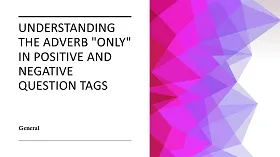The Adverb "Only" and Its Use with Question Tags
In English Grammar, the adverb "only" can be paired with either a positive or a negative question tag. This subtle grammatical choice can influence the tone and meaning of a sentence. For example:
"There were only six people present, were there?"
"There were only six people present, weren't there?"
While both forms are grammatically correct, the positive question tag is more commonly used in everyday conversation. This preference often stems from the desire to maintain a neutral or polite tone.
Why the Positive Tag is More Usual
The positive question tag is often preferred because it aligns with the natural flow of spoken English. It avoids the potential abruptness of a negative tag, which can sometimes sound confrontational. For instance:
"You only ate one slice of cake, did you?"
"You only ate one slice of cake, didn't you?"
Here, the first sentence feels more conversational, while the second might imply doubt or criticism.
Expanding on the Nuances
Understanding the use of "only" with question tags requires a grasp of its placement and emphasis. For example:
Example 1: "She only visited Paris once, did she?"
This suggests curiosity or a neutral tone.
Example 2: "She only visited Paris once, didn't she?"
This might imply the speaker is seeking confirmation or expressing surprise.
In both cases, the adverb "only" modifies the verb, but the choice of tag alters the sentence's emotional undertone.
Final Thought
Mastering the use of "only" with question tags can enhance your fluency in English. While both positive and negative tags are correct, the positive tag is generally more common and versatile. By paying attention to context and tone, you can use this grammatical structure effectively in both spoken and written English.









